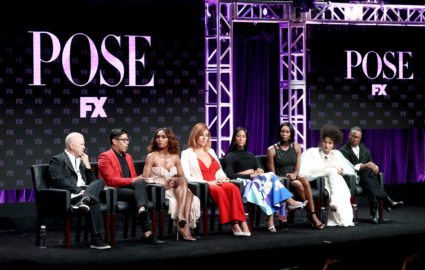
Pandemic eats into LGBTQ representation on network TV, study shows
NEW YORK — LGBTQ and gender inclusiveness on television has retreated slightly this season due to delays and shutdowns caused by the COVID-19 pandemic, according to a new study out Thursday by the advocacy group GLAAD.
The percentage of regularly seen LGBTQ characters on streaming as well as prime-time broadcast TV and cable during the 2020-21 season fell. Prime-time broadcast fell to 9.1% after reaching an all-time high of 10.2% last season. That represents the first decrease since GLAAD's 2013-14 report.
"We're hoping that is just a blip and not the beginning of a trend," GLAAD's President & CEO Sarah Kate Ellis said in an interview, adding that the decrease overall was largely due to fewer shows being made.
GLAAD's report, "Where We Are on TV," found that 70 out of 773 series regular characters on broadcast scripted prime-time TV were LGBTQ. Last year, those numbers were 90 out of a total of 879 characters. Recurring LGBT characters were also down.
There were also declines in LGBTQ representation on streaming services and prime-time scripted cable shows, triggered in part by production shutdowns of such series as "The L Word," "Euphoria" and "Killing Eve."
GLAAD is asking the industry to reach 20% representation of LGBTQ regularly seen characters on all three platforms by 2025, and to ensure that half of LGBTQ characters on every TV platform are people of color within the next two years.
The group found good news on the second request in the latest study — over half of LGBTQ characters on cable television were people of color, meeting GLAAD's challenge. And for a second year, GLAAD counted more LGBTQ regular and recurring women on prime-time broadcasts than LGBTQ men.
WATCH: 2020 in review: Stories on criminal justice, LGBTQ rights and race
The advocacy group noted that nearly half of all LGBTQ representation in prime-time scripted cable is seen on just three networks — FX, Freeform and Showtime. It urged other networks to follow their lead.
The report also found that nearly one in every five LGBTQ characters is connected to just four show writers and creators — Shonda Rhimes, Greg Berlanti, Lena Waithe and Ryan Murphy.
Ellis noted that data from the Nielsen company shows that pandemic-affected Americans — age 18 and over — are averaging 37 hours of TV a week — almost a second full-time job. That means the stakes are even higher for GLAAD's goals of reaching representation, even as the fragility of positive movement is clear.
"The content is more important than ever and it's having a bigger impact than ever. So for us we're thrilled that the drop wasn't as big as it could have been. But, if all things are equal, then even if the quantity of programs goes down, the representation shouldn't," Ellis said.
An estimated 4.5% of adults in the United States, approximately 11.3 million people, identify as LGBTQ, according to the Williams Institute at UCLA School of Law. GLAAD and
The Harris Poll have found that 20% of Americans ages 18-34 identify as LGBTQ.
While streaming and cable shows have found homes for LGBTQ characters, GLAAD focuses on gains made on broadcast channels because, unlike those TV alternatives, channels like ABC, NBC, CBS and Fox are in everybody's household.
"We still do focus on broadcast because that's where a majority of Americans are still taking in and absorbing content. That's still where the majority of Americans might meet their first gay person or transgender person or bisexual person for the first time," Ellis said.
GLAAD also found that the number of characters living with HIV plunged from nine to three — all three on FX's "Pose," set in the late 1980s. The organization is calling on the industry to introduce no less than three new regular or recurring LGBTQ characters living with HIV each year on cable or broadcast primetime.
Support Canvas
Sustain our coverage of culture, arts and literature.


















